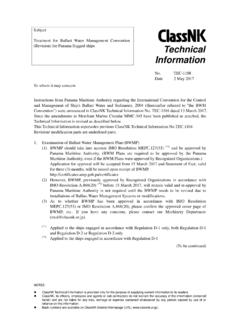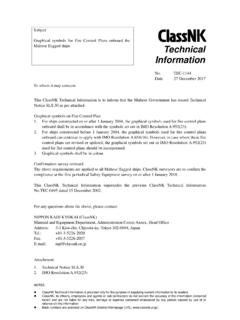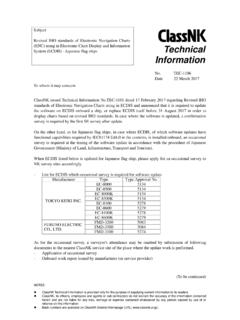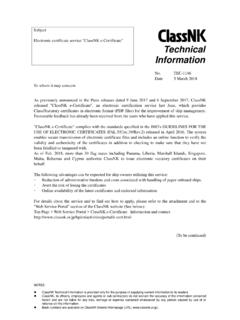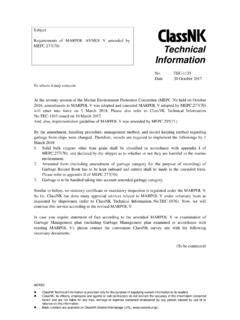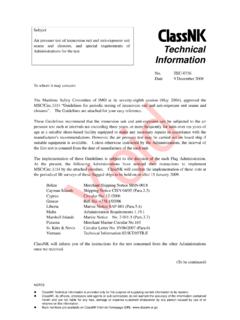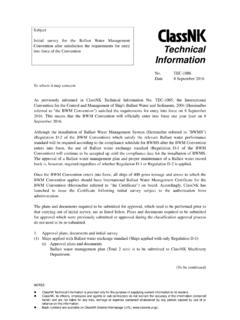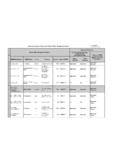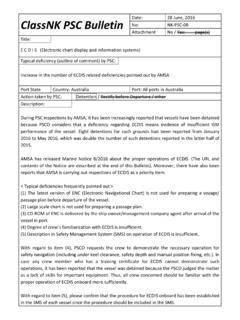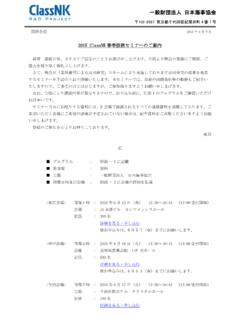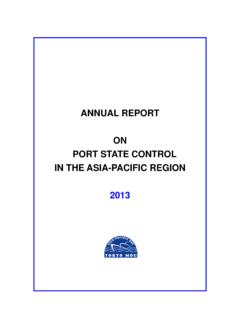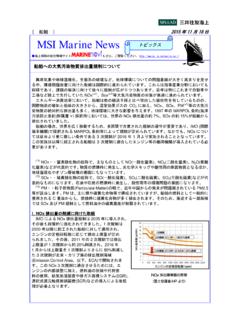Transcription of PSC16E - ClassNK
1 June 2017 Port State Control Annual Report[English]PPhhoottooggrraapphhss ooff DDeeffiicciieenncciieess iiddeennttiiffiieedd dduurriinngg PPoorrtt SSttaattee CCoonnttrrooll FFiirree SSaaffeettyy Leakage from fire line Dis-connected pilot line for fixed CO2 fire extinguishing system Detached insulation on underside of deck Improper cable penetration (through fire door frame) FFiirree SSaaffeettyy Wasted fire damper flap Holes on ventilation trunk and No marking of Open -Shut positi ons Hold-back hook fitted on self-closing door Emergency shut-off valve not ready for use (secured by wire) Holes No marking LLiiffee SSaavviinngg AApppplliiaanncceess Improper reset of on load release gear interlock lever Fractures on lifeboat hull Deteriorated reflective tape Poor condition of embarkation ladder LLooaadd LLiinnee Wasted gooseneck ventilator Hole on air pipe head Missing of hatchway securing device Wasted and corroded hatch cover securing device MMaacchhiinneerryy SSppaaccee MMAARRPPOOLL Oily and dirty engine room Oil leakage and accumulation Clogged oil water separator Pipe temporarily repaired with rubber patch
2 OOtthheerrss Deteriorated mooring line Corrosion holes on strength deck Crack at toe of hatch side coaming end bracket bbrraacckkeett ttooee eenndd Worn link and missing of stud ClassNK Annual Report on Port State Control Foreword This Annual Report on Port State Control (PSC) summarizes deficiencies identified during PSC inspections carried out in various countries around the world. This report is prepared with the objective of building awareness with the present state of PSC and thereby improving future onboard maintenance and inspections, and as well as Safety Management System. The report consists of the following Chapters. Chapter 1 : Status of Implementation and Recent Developments in PSC Worldwide Chapter 2 : Statistical Analysis of Detained Ships Registered to ClassNK Chapter 3 : Statistical Analysis of NK SMC Ships Detained by PSC (ISM Code) Chapter 4 : Statistical Analysis of NK MLC Ships Detained by PSC (MLC, 2006) Chapter 5 : Statistical Data from Tokyo MOU, Paris MoU and USCG Port State Control has been recognized to be a very direct and effective means to reduce the number of substandard ships as well as to improve safety of ships at sea and to prevent marine pollution.
3 The activity of PSC worldwide has significantly been strengthened along with the increasing number of amendments to the relevant international Conventions. Further to the above, in order to carry out the effective implementation of port state responsibilities, many countries have signed a Memorandum of Understanding (MOU) for regional cooperation between local PSCs, and have agreed to establish a centralized digitized database system and/or a harmonized approach. The scope of PSC inspection has been extended from the hardware aspect of the ship to the software aspect such as onboard maintenance or operational procedures ever since the ISM Code was adopted and applied to all ships and is still expanding as more new concept of regulations has been introduced by the adoption of ISPS Code, SOLAS amendments for bulk carrier safety, MARPOL amendments for prevention of air pollution or MLC, 2006, etc.
4 In line with the above progress of PSC, ClassNK has been working hard and will work harder to increase the transparency of information related to PSC and to eliminate substandard vessel. June 2017 Note: Every effort has been made to ensure the accuracy of the information presented in this report. However, as information is collected from a variety of sources, ClassNK cannot be held responsible for any erroneous data, judgements or conclusions that may appear in this report, in cases were the information available should prove to have been incomplete or incorrect in any respect. ClassNK Annual Report on Port State Control TABLE OF CONTENTS Chapter 1 Status of Implementation and Recent Developments in PSC Worldwide 1 Amendments to the relevant conventions 1 Enclosed space entry and rescue drills 1 Installation of stability instrument for oil tankers, chemical tankers.
5 Gas carriers 1 Appropriate portable atmosphere testing instrument or instruments to entry into enclosed spaces 1 Amended requirements for sludge discharging piping and bilge-water piping 2 An entry-into-force of the International Convention for the Control and Management of Ships Ballast Water and Sediments (BWM Convention) 2 The number of spare cylinders to replace those used during the drill 2 Revised IHO standards of Electronic Navigation Charts (ENC) using in Electronic Chart Display and Information System (ECDIS) 2 Recent global developments 3 MOUs around the world 3 (1) European and North Atlantic region (Paris MoU) 3 (2) Asia-Pacific region (Tokyo MOU) 4 (3) Latin-American region (Latin American Agreement) 4 (4) Caribbean region (Caribbean MOU) 4 (5) Mediterranean region (Mediterranean MoU) 4 (6)
6 Indian Ocean region (Indian Ocean MOU) 5 (7) Black Sea region (Black Sea MOU) 5 (8) West and Central Africa region (Abuja MoU) 5 (9) Arab States of the Gulf (Riyadh MoU) 5 Port State Control in the United States (USCG) 6 Equasis 6 Measures adopted by ClassNK 7 Handling of the Deficiencies Identified by PSC Inspections 7 (1) Cooperative assistance with PSC and treatment of the deficiencies 7 (2) Treatment of inspection reports by PSC officers 7 Minimizing the number of detained ships in order to reduce substandard ships 8 (1) Special training at several in-house meetings 8 (2)
7 Meetings and informal gatherings with management companies 8 Visits to PSC authorities 8 Chapter 2 Statistical Analysis of Detained Ships Registered to ClassNK 9 General 9 Data on Detentions 9 Detentions per Flag State 9 Detentions per S hip Type 11 Detentions per Ship s Age 12 Detentions per S hip Size (Gross Tonnage)
8 13 Detentions per PSC Country 14 Detentions per MOUs and USCG 15 Analysis of Detainable Deficiencies 16 ClassNK Annual Report on Port State Control Detainable Deficiencies per Category 16 Frequently Reported Deficiencies 17 Analysis of Detainable Deficiencies per PSC Country 23 Australia 23 China 24 Russia 25 Japan 25 26 Indonesia 26 Spain 27 United Kingdom
9 27 Romania 28 Italy 28 Iran 29 Germany 29 Chapter 3 Statistical Analysis of NK SMC Ships Detained by PSC (ISM Code) 30 General 30 Statistics of Detentions of NK SMC Ships 30 Analysis of ISM Detainable Deficiencies 32 Australia 32 China 34 Japan 35 EU Member Countries
10 36 Chapter 4 Statistical Analysis of NK MLC Ships Detained by PSC (MLC, 2006) 38 General 38 Statistics of Detentions of NK MLC Ships 38 Analysis of MLC Detainable Deficiencies 39 Chapter 5 Statistical Data from Tokyo MOU, Paris MoU and USCG 42 Tokyo MOU
